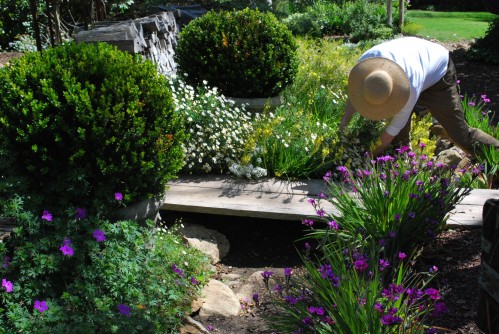 This past spring, the Village Garden Club of La Jolla brought Englishman Shane Connolly to San Diego for it's fifth "Meet the Masters 2012" program. This program is an annual garden club highlight, and it's keynote speakers are generally the highest caliber of internationally acclaimed floral designers.
This past spring, the Village Garden Club of La Jolla brought Englishman Shane Connolly to San Diego for it's fifth "Meet the Masters 2012" program. This program is an annual garden club highlight, and it's keynote speakers are generally the highest caliber of internationally acclaimed floral designers.
In April of 2011, Shane Connolly led the floral design team for the marriage of Their Royal Highnesses, the Duke and Duchess of Cambridge, better known as Prince William and Kate Middleton. Remember the surprise tree-lined aisle inside Westminster Abbey. Connolly has designed floral creations for the royal family for over twenty years. Known for his sustainability interests and natural approach to floral design, his clientele is worldwide.
During his time in the San Diego area, while demonstrating his floral design, Connolly spoke freely on his unique approach to floral design. Connolly has a broad foundation as an artist and a musician. His first professional field was psychology, and his floral design career blossomed unexpectedly from friends urging him to try it.
Connolly is proficient in the symbolic language of flowers and this knowledge only enhances his floral designs. Connolly's sustainability interest and natural approach to floral design is simply refreshing. Connolly was also eager to tease his enthusiastic audience with tiny snippets about Prince William and Kate Middleton's wedding.
Connolly demonstrated and spoke his way through numerous floral designs at his formal presentation at the Museum of Contemporary Art in La Jolla, on Thursday, March 8, 2012. The following day, he toured, created a massive floral design, and enjoyed a social lunch at Lani Freymiller's North County private garden with a distinguished group of 35 LJVGC members.
Freymiller, a retired grade school teacher, is an artist in her own right with an impeccable eye. She has designed her breath-taking garden slowly over a period of nearly 40 years, and has received countless accolades and recognition. Perhaps the grandest compliment yet, is her local garden receiving this royal treatment.
Touring through Freymiller's stunning garden, Connolly choose sprays of Cherokee Rose, Tuscan Blue Rosemary, Pearl Acacia, Mock Orange, Rue, Silver Waves Camellia and many others. He also shared best pruning practices, such as prune from the trunk always, and prune first errant growth at the bottom of plants. In time, he had his desired mixture of garden cuttings to create his grand garden floral design. His container of choice naturally was a vintage tub.
Connolly charmed everyone, as he continued to share his design tips and philosophy. Freymiller was a gracious and extraordinary hostess, warmly sharing her beautiful garden. This special day will be fondly remembered by those attending for a very long time.

Connolly's Tips for Timeless Artisan Floral Decorations & Sustainability:
-- "Use a few seasonal flowers simply, with the prime objective of showing them off and emphasizing their individual characteristics."
-- "Designs live on after being created."
-- "Group things together, it is more like they grow in the garden."
-- "Use chicken wire, instead of an oasis. Put flowers in water."
-- "Let flowers tell you where it wants to be in the arrangement. Lovely to let flowers do what they want to do."
-- "When you've done something, walk away from it. You can angst too much over flowers, and take their soul."
-- "Conditioning of things is most important, and the condition of things."
-- "I like shades of color. Don't dilute color with green."
-- "I like things that look like they were grown in someone's garden."
-- "I like using two same containers in different sizes."
-- "When doing an arrangement, tougher things go in first."
-- "You want a physical balance, as well as a visual balance." Antithesis of arrangements is to make a shape. Asymmetrical looks artful."
-- "The love of garden dictates your designs."
--"I think everyone should get their hands in some mud."

 Do you have an abundance of tomatoes right now? The best recipes from the garden are the simplest--letting natural flavors shine on their own. Insalata Caprese is all about fresh, natural flavors of summer. If you have a plethora of tomatoes now, try this Insalata Caprese recipe from Red, White, and Greens : The Italian Way with Vegetables
Do you have an abundance of tomatoes right now? The best recipes from the garden are the simplest--letting natural flavors shine on their own. Insalata Caprese is all about fresh, natural flavors of summer. If you have a plethora of tomatoes now, try this Insalata Caprese recipe from Red, White, and Greens : The Italian Way with Vegetables



 Following after the "Slow Food" movement, Prinzing and Perry introduce us to the "Slow Flower" movement. Do you know where your flowers are grown? When they were harvested? If chemicals were used to grow them? Prinzing and Perry introduce us to local organic flower growers, gathering, and ultimate "Slow Flower" design. Using fresh flowers out of our own gardens is one easy step in this direction.
Following after the "Slow Food" movement, Prinzing and Perry introduce us to the "Slow Flower" movement. Do you know where your flowers are grown? When they were harvested? If chemicals were used to grow them? Prinzing and Perry introduce us to local organic flower growers, gathering, and ultimate "Slow Flower" design. Using fresh flowers out of our own gardens is one easy step in this direction.




 .
.
